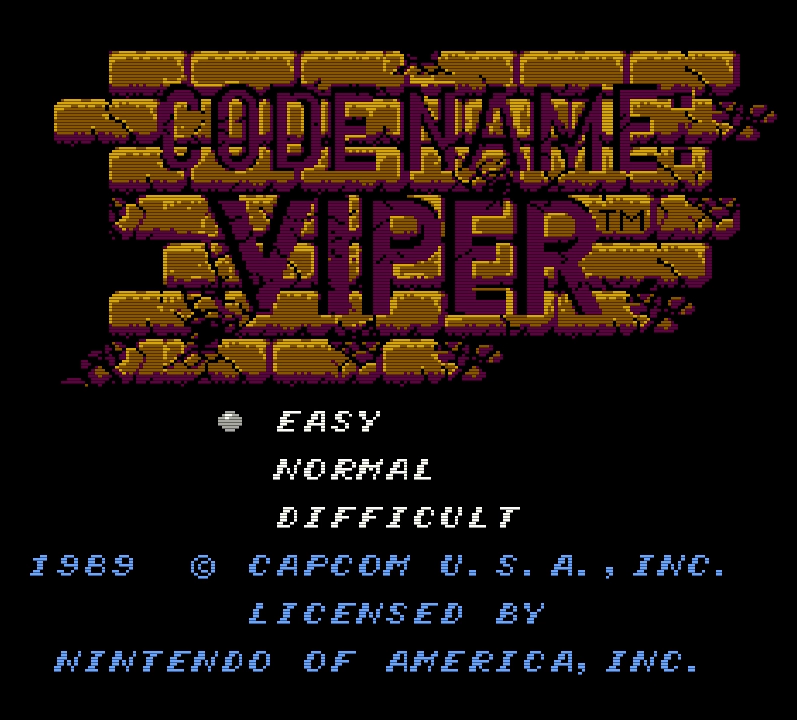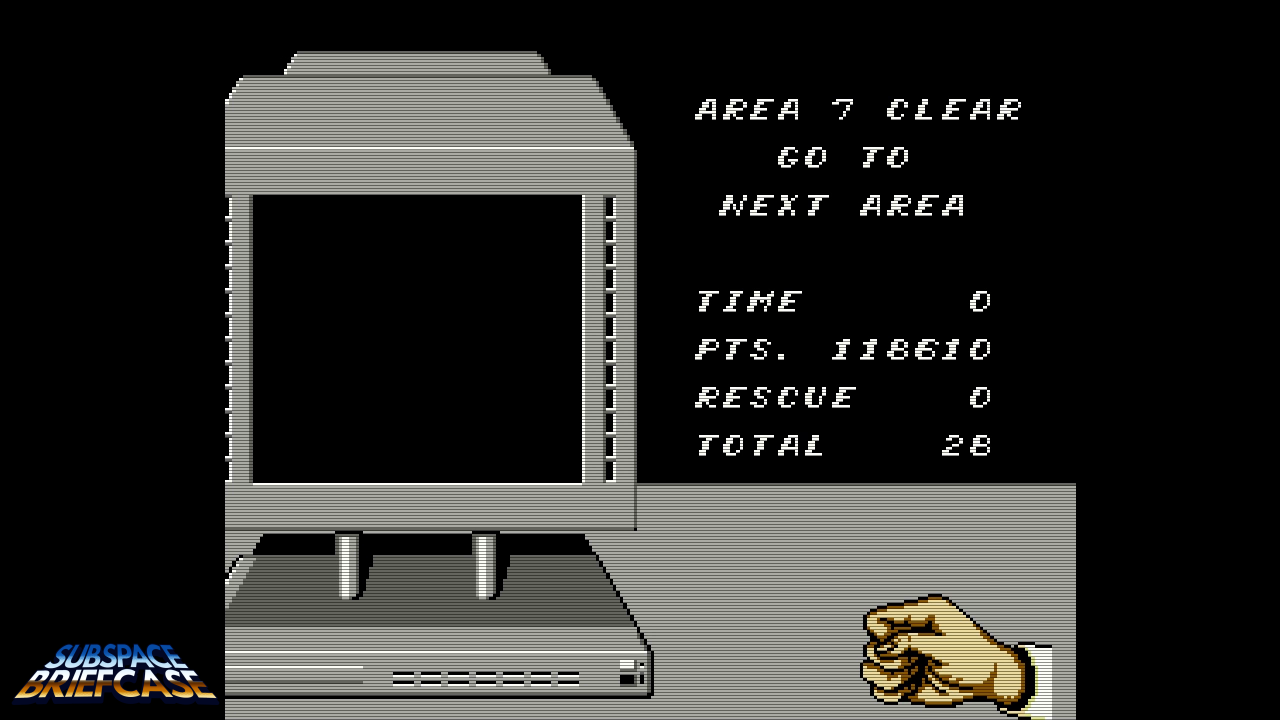 Code Name: Viper
Code Name: Viper
Nintendo Entertainment System, 1990
Developer: Arc System Works
Publisher: Capcom
As anyone who walked into an arcade between the years of 1989 and 2000 can tell you, winners don’t use drugs. This of, course, is why drug dealers make for fantastic video game adversaries. Today, franchises like Grand Theft Auto sell millions of copies on the backs of protagonists who openly deal in narcotics. In the late ’80s and early ’90s, however, gamers were far more likely to be destroying drug labs than running them. Of all the games that sailed on the wave of the “just say no” sentiment that was pumped into my brain during the Reagan/Bush era, Capcom’s Code Name: Viper is indisputably my favorite.
Like most games of its vintage, Code Name: Viper has the simplest of plots – you couldn’t even roll a joint with the paper it would take to transcribe the whole thing. The player assumes the role of Kenny Smith, whom we can only assume is the eponymous “Viper,” as the game never refers to him as such. An agent of “Special Missions,” Mr. Smith has been tasked by his cigar-smoking superior, Commander Jones, with destroying the seven hideouts of “the huge drug syndicate in South America.” In each location, he must also recover one of his fellow agents, who has been “hurt and captured” by the syndicate. Simple stuff, right? OR SO THE U.S. GOVERNMENT WOULD HAVE YOU THINK. But we’ll get into that later.
Mr. Smith can do 5 things:
- Walk
- Jump
- Jump higher
- Duck
- Shoot
It’s a pretty basic moveset for a guy code-named after a venomous snake, but it’s not Mr. Smith’s moves that make the game so enjoyable, it’s the level design. Generally speaking, the action in Code Name: Viper takes place across two parallel planes – a high plane and a low plane. Both Mr. Smith and the legion of literally faceless enemies that stand in his way can freely travel between those two planes by way of a perpendicular leap. Each plane is also populated with various objects that effectively serve as waist-high cover for Mr. Smith’s adversaries.

Additionally, each stage is filled with an absolutely absurd amount of “secret” revolving doors; I’m not exaggerating when I say that nearly every entryway in this game is both concealed and rotating. I’ve seen Narcos; I know secrecy is important drug cartels, but Code Name: Viper takes it to ridiculous lengths. In addition to containing power-ups and hostages to rescue, these doors also serve as a means of hiding from enemies. By holding up on the control pad, Mr. Smith can remain inside a door for as long as he likes, during which time he is impervious to harm.
As Mr. Smith has the smallest of life bars, the player is forced to dart between both planes, around cover, and into hidden doors in order to get the drop on enemies without taking any damage. It’s a nice little gameplay cocktail which makes for some fairly exciting action. Take a look:
Each level ends in a dead-end. Mr. Smith cannot break through these barriers until he has rescued the captured commando hidden in each stage, who, inexplicably, will be carrying high-powered explosives. As I assume that any “huge drug syndicate” with the foresight to cover half of South America with hidden revolving doors would have frisked its captives, we can only assume that these commandos have swallowed these live explosives, like so many condoms full of cocaine, and retrieved them rectally. Talk about using your enemies’ methods against them.

At the end of each level, Mr. Smith sits down with the commando he’s rescued, who reveals what syndicate secrets he’s uncovered. Invariably, what he’s obtained is a portion of an internal drug cartel memo, lovingly scrawled on what appears to be paper torn from a child’s wide-ruled notebook.

At each level’s conclusion, the player is also treated to an image of an unidentified person observing Mr. Smith’s progress through a state of the art CRT monitor:
Presumably, this person is a high-ranking member of the huge drug syndicate, as his hands take on a slightly more nervous posture as Mr. Smith closes in on the final level:
 This is a nice little touch which really adds a bit of spice to the game’s otherwise sparse plot.
This is a nice little touch which really adds a bit of spice to the game’s otherwise sparse plot.
With each commando he rescues, Mr. Smith uncovers more and more lines of the huge drug syndicate’s TPS reports. By the time the seventh stage has been completed, the entire vile, drug peddling plot has been lain bare before us.
Sweet Jesus. The WHOLE world? Not just through drugs, but BY DRUGS? And COMMANDER JONES is behind it? How could he do such a… uh…
That works. Thanks, Kenny!
But seriously, that memo is great. It reads like they’ve been having problems with the new hires contacting Commander Jones to refill the toner in the copy machine. It even concludes with “pay attention to this matter.” The only thing missing is a sentence about how Darla down in coca leaf processing is running a 5k to support prostate cancer survivors, and donations can be left in the jar behind the secret door in the mail room. Let’s not even touch the fact that they divulged Commander Jones’ location for absolutely no reason whatsoever.
Obviously, Commander Jones is not pleased with these developments:
HE SMACKED THE TABLE SO HARD THE MONITOR TURNED OFF. HOT DAMN! While this plot twist has very little impact, I’ve always enjoyed the way these little interstitial scenes play out over the course of the game.

Of course, this revelation leads to a surprise EIGHTH stage where the player must infiltrate Commander Jones’ chic Beverly Hills drug den and defeat him in a surprisingly brief, but challenging, boss battle. At the conclusion of the game, we’re treated to a brief text scroll of an ending:

Yep, Kenny Smith goes full on Dirty Harry. He even gets rid of his badge:

If you think about it, this ending could be viewed as a little bit subversive. While it’s not rare for NES games to invoke the “your employer is the villain,” trope, in Code Name: Viper your more or less working for the CIA. The game is as much a critique of the US government as it is an indictment of drug cartels. Pretty weighty stuff for something that was sold as a toy for children. SEEDS PLANTED. Well done, Capcom.
I’ve always felt that Code Name: Viper is one of the more under-appreciated titles in the NES catalog. It has more or less vanished from most gamers’ memories, despite having stellar graphics, a refined, yet simple, control scheme, and uncommonly catchy music. But there’s a very good reason why history hasn’t been kind to Code Name: Viper – it’s a blatant rip-off of another game. But we’ll save that for Part 2. Tune in next time!









